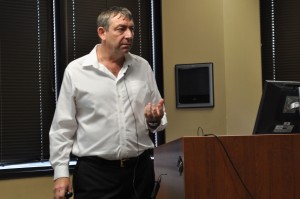Condition monitoring calls for drilling contractor, OEM collaboration
By Katie Mazerov, contributing editor

Evaluation and recertification programs for equipment and systems are plentiful, but offshore contractors are looking for practical solutions that are universally acceptable in the industry, particularly for risers, pipe-handling systems and blowout preventers. “Drilling contractors are at the front end of the curve in condition monitoring,” Steve O’Leary, technical services director for Seadrill, said in a presentation at the IADC Rig Condition Monitoring Workshop, 19 January in Houston. “We need to know what to monitor, how often to monitor, when and why we’re doing it and what to do when we see a change in condition.”
Current practices that involve automatically changing out existing equipment/components for new is costly and inefficient,, but switching to a condition-based maintenance and monitoring program will require more cooperation between the original equipment manufacturer (OEM) and the people on the rig.
“The OEM must provide guidance for maintenance and acceptable criteria for continued operations that are condition-based, not merely calendar-based, for hydraulic systems, vibration analysis on thrusters and other critical functions,” Mr O’Leary said. On the drilling contractor side, they must understand the difference between the OEM “certifying” the equipment and “re-qualifying” the equipment as fit for purpose. The latter requires the contractor to actively inspect and maintain equipment so that it meets manufacturer and regulatory requirements.
“We also need to know when a system has wandered away from its normal mode of operation,” Mr O’Leary continued. “Some contractors choose to inspect equipment after a fixed, in-service period, and some carry out the inspections on a routine calendar basis. Both methods contain risk. An enhanced asset management strategy will ensure that we reduce, as far as reasonably practical, the risk and potential for equipment to fail,” he said.
Deepwater especially critical
Such measures are especially important for deepwater operations, where inspection programs can’t merely be fault-finding exercises, Mr O’Leary said. “We should not accept anything less than a 100% inspection of critical components.”
Going forward, drilling contractors should work with OEMs to review inspection protocols and develop long-term business plans. An asset management plan that includes, among other things, baseline inspection procedures that can define changes in systems and equipment that would require repairs and ensure the assets are fit for continued service, is also necessary, Mr O’Leary said. “A baseline plan will establish a system of historical performance that can ensure more meaningful capture of real-time information and enable the development of signature testing in a number of ways.
“An ideal inspection program for offshore rigs should include ongoing riser and pipe-handling inspections and BOP monitoring, which are critical,” he continued. “We do spot checks now, but often spot checks don’t pick up systemic problems.”
And although equipment-monitoring systems should ensure safety, they also must deliver cost efficiency. “Our systems sometimes fail or shut down for an entire day because the monitoring systems aren’t smart enough to tell us in advance that a piece of equipment needs to be shut down and why,” Mr O’Leary said. “We need monitoring systems that are minimally intrusive, safe and easy to use. We need to know something is wrong before it goes wrong.”





je suis à la recherche une place en qualité de foreur ou producteur je suis base en well control production fond